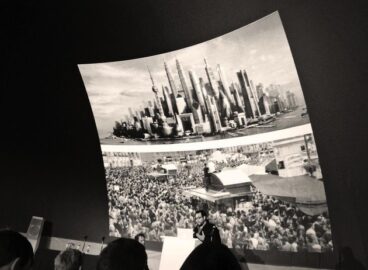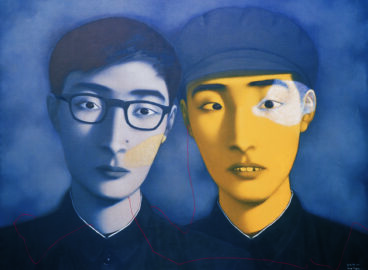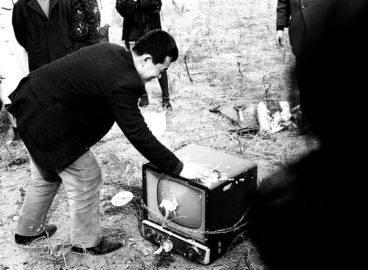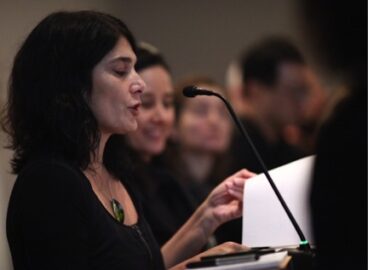What are the goals of an archive based in a region where the local art scene is still finding its place in the world map of contemporary art? How to approach contemporary art in the region if no linear social, political, and art history can be told? How can archives be instrumental in helping regional initiatives in art education and documentation?
Claire Hsu, cofounder and director of the Asia Art Archive, which was established in 2000, gave this talk in April 2013 at C-MAP’s annual two-day seminar held at The Museum of Modern Art. Titled “Global Networks,” the event provided an opportunity to discuss approaches to modernity in Latin America, Asia, and Central and Eastern Europe, the regions of C-MAP’s current focus. Hsu contends that in Asia it is important to go beyond notions of modernity and contemporaneity and to prioritize the search for local histories, and to develop methods to connect and activate the resulting knowledge, a quest in which the archive plays an instrumental role. In this presentation, Hsu introduces the work of the Asia Art Archive as a model for considering some of the questions around ethics, network practice, and collaborative research that were addressed in the seminar. She describes the Asia Art Archive’s initiatives in documentation and public programs in East and Southeast Asia as examples of how the archive can serve as an anchoring point for different parts of Asia, each with its own past and contemporary history. Rather than a mere accumulator and disseminator of material, the archive, as envisioned by Hsu, does not aim to tell a comprehensive story but instead to actively engage and promote participation and exchange among regional networks of artists, critics, curators and scholars and to help local initiatives move forward.
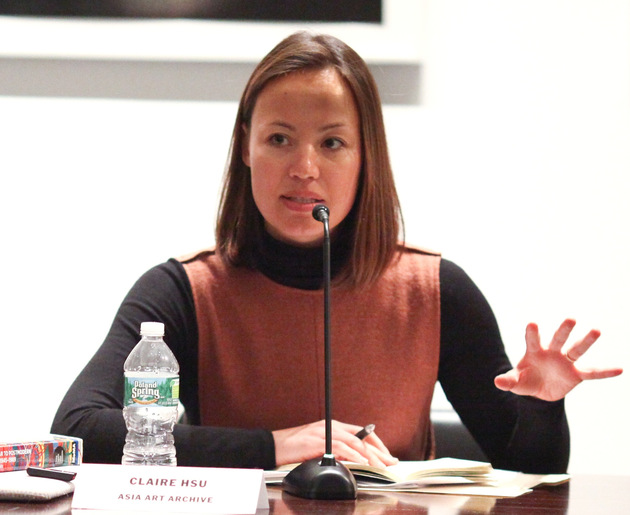
While we often casually speak of this all-encompassing Asia, we are also aware that the construct of Asia is one that is fraught for multiple reasons. At the same time, we are cognizant of the implications of our well-intentioned meanings recreating the very power structures that we are looking to break down, and so long as Asia Art Archive is one of the few visible platforms doing this kind of work, these entry points fall into the danger of canonizing or even misinterpreting the histories of the region. We have started with the premise that our approach to Asia is not to tell an Asian story, but rather what might be best described, using the title of Chen Kuan-Hsing’s book, as Asia as Method. The idea of using Asia as an imaginary anchoring point is one that resonates with our approach to echo Chen: we are imagining a space in which the objects of identification can be multiplied and alternative frames of reference constructed so that societies inside and outside Asia can become each other’s points of references—to provide alternative horizons and perspectives to those well traveled.
What exactly does Asia Art Archive say about the history of art in Asia? While on the one hand it provides a number of possible entry points for considering the discourses around modernity and the contemporary in the field and allow for the comparison or retracing of certain ideological networks, it fails to tell any comprehensive, official kind of history. And to be clear, this is not our intent or our interest. We are well aware of the impossibility and absurdity of the idea that a single archive can tell this entire story.
As evidenced by the increasing use of the word “archive” as a generic term, the proliferation of archive- driven networks, institutions and programs, as we see here today, and the move to digitize and make public previously inaccessible bodies of material, the archive has evolved into a multi-functional space. It is no longer about the ordering of objects within a structure, but a platform that enables the co-creation of meaning and experiences, where knowledge is envisioned as an inter-subjective space. And I would argue that the idea of the network is inherent as a form within this.
The Asia Art Archive, an independent non-profit organization, was founded in Hong Kong in 2000, at a time when the importance of the network as a shared space of affinities between artist-run spaces in the region was at an all-time high. In fact, before we even had doors to open, we co-organized our first program with an independent art space called Para Site. It was a conference called “Conference Space Traffic,” and it served specifically as a platform to bring together artist-run spaces from around the world.
Our current focus on digitizing the records of pioneer organisations, many of which are defunct today, is very much because of the context out of which AAA was born and the importance these institutions had as a network in shaping alternative discourses around art in the region. One thing that is clear is that we have never been so networked. As we sift through our daily emails, websites, social network accounts, access to information, the possibility to connect and the potential to illuminate have inevitably opened up prospects to imagine and create new knowledge structures and networks. And what is becoming obvious is the promise of the archive in this. So, since its beginnings, AAA has been dedicated to documenting and increasing access to information on the recent histories of art in Asia. Histories that continue to be difficult to research, where material and documentation are scattered and writings sparsely translated.
AAA may be seen as one of several attempts to balance the way in which knowledge around contemporary art is accessed, produced, activated, engaged and circulated in a region where national agendas and market forces increasingly dominate and shape this reading. This is the premise for the current formation of a number of networks and institutions emerging in different historical contexts and localities of differing structures, in regions outside the dominant centers of knowledge and canons of history. AAA’s goal is to facilitate much needed research, scholarship in, and historicizing of the field by making a collection of material freely accessible from its physical space in Hong Kong and from its website. While you can find what you would expect in every library—reference books, exhibition catalogues, periodicals and monographs—AAA’s collection also includes an emphasis on gray literature, so, small catalogues, ephemera, as well as a digital collection of over tens of thousands primary and secondary documents collected through a systematic program of research and information gathering by the team in Hong Kong and project researchers in different cities in Asia, and also with a rotating advisory board.
Bringing a substantial body of material into the public realm last year pressed AAA into further considering its responsibility as not only the accumulator and disseminator of this material, but its role in how the material will be interpreted and built upon. Or as Filipino art historian and critic Patrick D. Flores proposed in a round table at AAA, how we inflect rather than interpret the content of our collection from a specified alignment. And this is where the idea of mapping and networks is of utmost priority going forward as we focus on more concretely connecting to other initiatives and experts in the field. In some way similar to the cartographies project of the Southern Conceptualisms Network, we’re undertaking a series of mapping exercises not only to re-evaluate and contextualize the material in AAA’s collection—and these maps will be shared publicly—but to be able to identify and locate other bodies of material which we can connect to possibly through a shared digital platform.
At the same time as we embark on projects going forward, we will constantly be considering what tools are generated from these projects, what work these programs actually do beyond their running dates. How AAA is able to act as a catalyst—how it can help facilitate other such initiatives in the region, is a priority. An example of this is the mobile library project, which was originally conceived as a way of sharing the material within AAA’s collection with resource-poor cities. The pilot mobile library project went to Saigon in 2011. We worked with our partner there, Sàn Art, which is an independent space in the city, and they organized over three months a series of programs with different segments of the community. This time around, with our partners Raking Leaves, we have taken the mobile library to Jaffna in Sri Lanka for three months, where it’s currently installed in the Christa Seva Ashra and has been integrated into the daily curriculum of the University of Jaffna’s fine arts department. This is not only an important resource for the students who do not normally have access to this material—in fact Jaffna’s library was burned down during the civil war—but more importantly will result in the creation of an archive for Sri Lankan art and design which will stay on in Sri Lanka as an independent archive.
Over the years we have consistently held programs to include talks, symposia, artists’ residencies, research grants, high school programs, and as we enter what I would consider a second life phase, our goal is to focus and streamline all of these programs so that they constantly help us to critically think through the archive and its collection, and thus reshape it as we go along. So, not only Asia as method but also archive as method.
In line with thinking together about AAA’s new website, we launched Field Notes, a bilingual e-journal intended to provide a more in-depth reflection on issues prevalent in the field and a public thinking space for AAA. Again, with Asia as a malleable anchoring point. For the first issue we began by looking at the notion of contemporary art, with specificity to the context in Asia. One of the most referenced documents on contemporary was American art historian Hal Foster’s questionnaire, sent out in 2009 to critics and curators in North America and Europe. So considering the role of the non–Western world within this conversation, a deeply entrenched relationship of the contemporary to the global, it was an interesting proposition for the questionnaire to be resuscitated and addressed from alternative latitudes, which we did. In the first issue, we present responses to AAA’s expanded and mutated version of the questionnaire from over 40 professionals in the field that we work closely with.
The responses to the questionnaire not only map the multiple and disjunctive layers in which one must consider contemporary art in Asia, but go further and make apparent the urgency to consider the origins and the usages of the very words “contemporary” and “modernity” in the art histories of the region. For there are different histories for these words in different countries. A number of the responses cite that the problem with the current use of “contemporary” in incorporating art from other parts of the world following modernity, is that it does so without any serious threat to Western hegemony. And therefore, there is an overall call for a history of specifics or a scholarship of specifics.
Art historian Atreyee Gupta calls for a re-introduction of a politics of place into the conceptualization of contemporary art and contemporaneity. On the one hand, she replaces the obscurity of the global—of the no nation, no history, no place—and on the other, she urges us to consider a new ethics for transformational art practices that have emerged through the politics of locality. As Patrick Flores argues, it’s how we connect history to place that determines whether and how the resistance to totality can be waged.
It is how we connect and activate the knowledge within and outside the archive to other knowledge networks and nodes that will be essential going forward. How do we understand our neighbors in different spaces and time? How can we create a contemporary language that does not simply revisit existing binaries, and how do we translate the intellectual sources of regional modernity into globally comprehensible terms? Using the archive as a method in which the network is an inherent strategy, we hope to provide one of the possible spaces in which these questions can be tackled.
